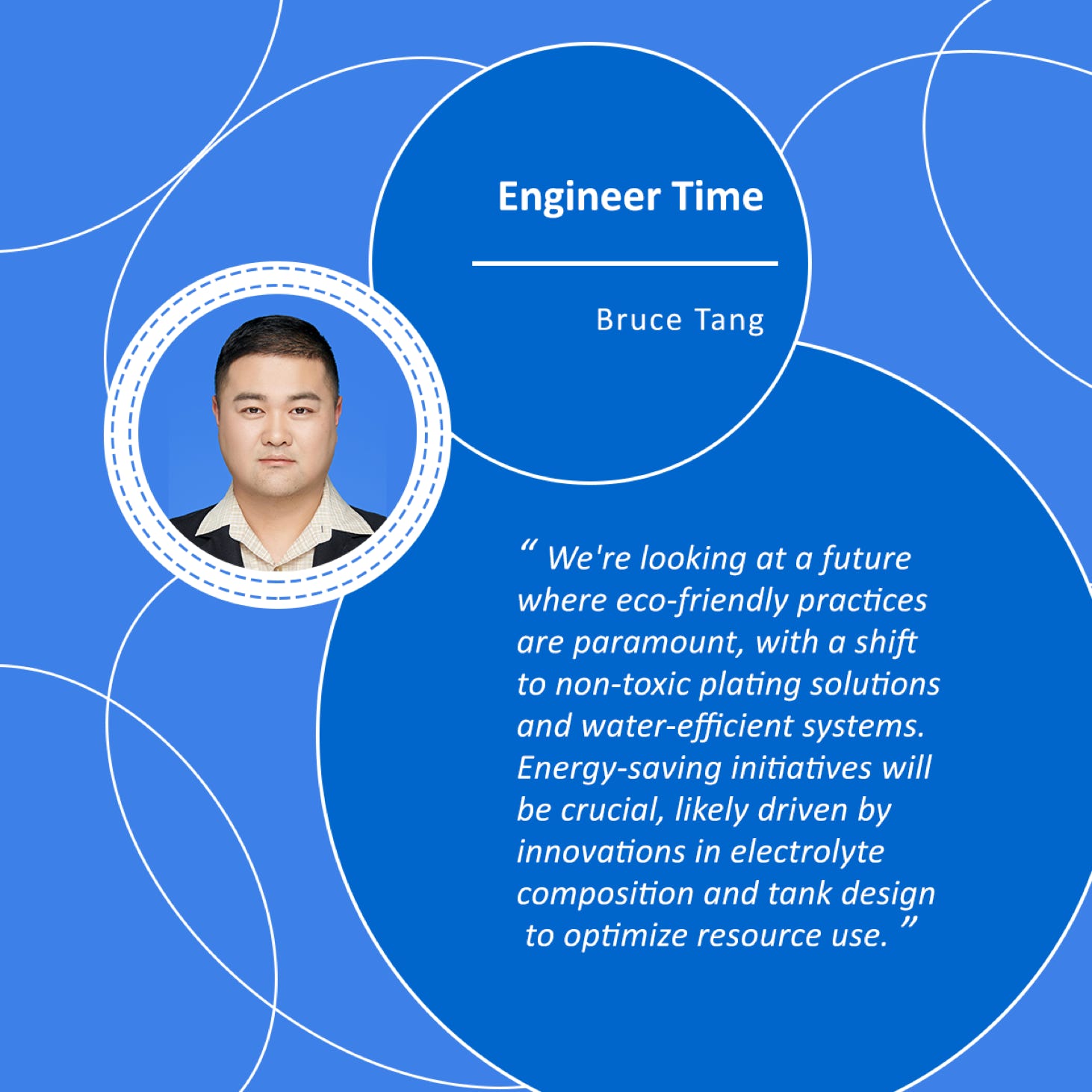Q1: Could you introduce yourself and your professional background?
My name is Bruce Tang, and I work as a Surface Treatment Engineer at Foresee Group, bringing 15 years of dedicated experience in the surface treatment industry to the table. My expertise lies in the intricate development of surface treatment processes and additives, with a particular focus on optimizing these processes to meet application-specific requirements. This involves devising customized surface treatment solutions that enhance the final plating quality, while also pioneering new techniques and methodologies aimed at improving process efficiency and production throughput. My role demands a deep understanding of the electrochemical principles underlying surface treatment, along with a keen ability to adapt these processes to various industrial needs and challenges.
Q2: What is the primary responsibilities of a surface treatment engineer?
As a surface treatment engineer, my responsibilities are multifaceted, encompassing the development of surface treatment processes tailored to customer demands and product specifications, which includes surface preparation, electrolyte formulation, and parameter setting. Additionally, I am involved in the design and optimization of surface treatment equipment to achieve desired outcomes, process improvement for efficiency and cost reduction, stringent quality control and management, equipment maintenance and troubleshooting, as well as overseeing safety and environmental considerations within the surface treatment process. Project management and providing technical support and training to staff are also key components of my role, ensuring project deliverables meet time and quality benchmarks.
Q3: What are the key considerations when designing coatings for different projects?
The demands for surface treatment vary significantly across different project types, leading to distinct considerations and priorities in the design of plating coatings based on the specific circumstance. For example, in surface treatment of electronics, the primary considerations are enhancing conductivity and ensuring corrosion resistance. For aerospace parts surface treatment, it's all about enhancing corrosion resistance and reducing weight. Precision mechanical parts tend to prioritize surface smoothness and wear resistance in plating. As for medical equipment, hygiene and corrosion resistance are important considerations. This diversity in requirements compels me to devise bespoke coating designs that resonate with the practical needs of each industry segment. In doing so, my design process usually involves analysis of several key factors, including the type of substrate material, the intended function of the coating, desired thickness, material selection, surface quality, operational environment, and considerations of cost and feasibility.
Q4: How do you ensure quality consistency across surface treatment projects?
Ensuring quality consistency across surface treatment projects starts from the coating design phase, where I actively consider whether the surface treatment outcomes will meet client requirements. The factors I mentioned previously—such as substrate type, coating purpose, thickness, materials, and surface quality—are keys of successful plating. These are integrated with appropriate processing techniques. Post-processing, we employ various testing devices analysis instruments to verify if the final product's coating, including dimensions and performance attributes, aligns with our expectations. Also, establishing standards and specifications is crucial, covering surface treatment process parameters, coating thickness, color, and gloss level, to ensure batch-to-batch consistency. If production results are inconsistent, we can always trace back to the root of the issue for resolution.
Q5: Can you share insights into cost management within surface treatment projects?
Cost management is not just about establishing long-term partnerships with multiple raw material suppliers at the source to get better prices and favorable conditions, as well as regularly evaluating market prices and adjusting procurement strategies on time. We also focus on cost management in production, such as optimizing the surface treatment process to improve efficiency and quality, reducing waste and rework rates. We provide operational training for on-duty workers and establish a strict quality control system to minimize the production of defective products, which can also reduce rework costs. At the same time, we optimize equipment operating time and temperature control, use efficient energy-saving equipment and lighting systems, and regularly inspect and maintain equipment to ensure normal operation and high energy efficiency. And of course, we rationalize the treatment of wastewater generated during the surface treatment process to reduce emissions and lower wastewater treatment costs.
Q6: Could you discuss a challenging project and your approach to resolving its difficulties?
Absolutely. I remember this one time during a project involved chrome-plating large components with intricate geometries. The issue was achieving a uniform chrome layer across the varied curvatures and contours of these parts. We had to design a custom electrode shaped to match the parts’ complexity, so it provides even current distribution during the plating process.
We figured the issue might have been due to inconsistent current density, suboptimal flow of the plating solution, or inadequate surface preparation. After some solid detective work and digging through records, we got to the bottom of it. We did some small-scale experiments to test out the tweaked setup and made adjustments based on the results until we nailed that chrome-plating effect we were after.
Q7: In the next 5-10 years, where do you see the future of surface treatment technology heading?
In the next 5-10 years, I expect surface treatment technology sets towards greater sustainability and efficiency. We're looking at a future where eco-friendly practices are paramount, with a shift to non-toxic plating solutions and water-efficient systems. Energy-saving initiatives will be crucial, likely driven by innovations in electrolyte composition and tank design to optimize resource use. As components get smaller, the precision of micro and nano-scale plating will become increasingly important. The integration of smart technologies for process monitoring and optimization will enhance production efficiency and consistency. Finally, the adoption of new materials for plating will address the diverse needs of various industries, from high-performance alloys to specialized coatings.
Q8: How do you continue improving your surface treatment engineer expertise?
I usually keep up to date by diving into academic journals and papers in my field, and attending industry conferences and exhibitions to catch the latest research findings, tech breakthroughs, cutting-edge developments, and trends. I also make it a point to stay in the loop by chatting with peers and industry experts to share new tech, industry developments, and project experiences. It's always a blast to have those lightbulb moments during these brainstorms. I appreciate the moments. The internet is a goldmine for learning, so I often hop into online courses, training, and webinars in my field. Practice makes perfect, right? That's why every project I get my hands on is another chance to dive deep and put that theoretical knowledge to work.
For more information about surface treatment, please feel free to contact us.
Click here to subscribe to our newsletter and receive updates on events.



